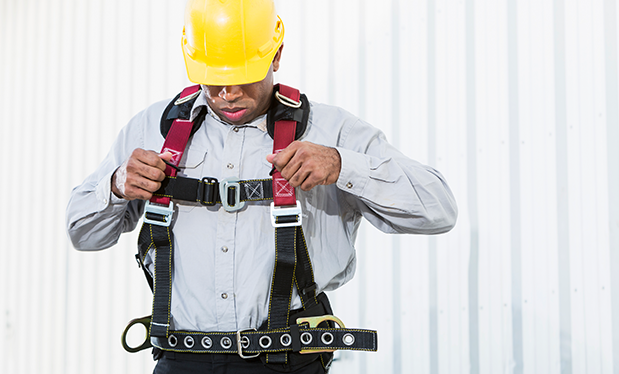About 1,500 miles southwest of Anchorage, Alaska, at the western tip of the Aleutian Islands is Shemya Island. Only 2 miles wide and 4 miles long, the small island is owned by the U.S. government and under the jurisdiction of the U.S. Fish and Wildlife Service as part of the Alaska Maritime National Wildlife Refuge.
In 1943, the U.S. military established an air base on the island now known as Eareckson Air Station. Named for Col. William O. Eareckson, a squadron commander during World War II, in 1994, Eareckson Air Station was deactivated and now is operated by about 50 civilian contractors. The station currently serves as an early warning radar installation with a principal purpose of monitoring space and missile activities. Since 2002, the National Missile Defense program has been an active participant on the island.
In 2014, a storm damaged Shemya Hangar 6 and its roof system required replacement. Rain Proof Roofing Co., Anchorage, was contracted to remove and replace the hangar's 44,000-square-foot roof system.
Logistics
Getting materials to Shemya Island is not an easy undertaking. All pedestrian transportation and material deliveries to the island are coordinated through one annual barge, a biweekly air freighter and a weekly commercial flight.
On April 26, 2016, Rain Proof Roofing began its off-site work. Through advanced preparation and coordination with material suppliers and the general contractor, Brice Environmental Services, an environmental remediation services company, Rain Proof Roofing procured and delivered material to the docks in Seattle by May 2 in time for the annual barge to deliver the material and equipment to Shemya Island.
Tear-off
On-site work began June 6, 2016, when Rain Proof Roofing sent a crew to receive the material from the barge and transport it by truck and trailer to the job site.
Hangar 6 has a barrel-shaped roof with a 260-degree arc and a 60-foot peak. There are three shed-style roofs at the building's rear and two 4-foot-wide roof coverings over the door pockets for the hangar doors.
Rain Proof Roofing workers removed the existing fully adhered EPDM membrane with mechanically attached batten strips, 3-inch-thick polyisocyanurate insulation, vapor retarder and gypsum substrate boards down to the steel deck.
The tear-off process was performed in two phases. The existing roof system from the eave to the peak first was removed to provide a standing ledge on which the crew could work. The joists on the structural steel deck were spaced 20 feet apart, so the welds were ground down to remove the deck's attachment points. Once the deck was free, workers used a combination of chains and extension lifts to remove the corroded steel deck.
New roof system
After a new structural steel deck was in place, the Rain Proof Roofing crew installed the hangar's new roof system. They used a telehandler forklift and a crane to hoist materials to the hangar's roof.
Workers loosely laid 5/8-inch-thick DensDeck® Roof Boards followed by a self-adhering V-Force™ Vapor Barrier Membrane, polyisocyanurate insulation, 5/8-inch-thick plywood sheathing installed with HeadLok fasteners, Titanium® PSU30 underlayment and .050-inch-thick, 12-inch ZIP-RIB standing-seam curved aluminum panels.
About 630 ZIP-RIB standing-seam panels ranging in lengths from 50 to 90 feet were fabricated and curved on-site within the hangar. Workers set up a series of staggered-height bunks to stage the curved panels for hoisting to the roof. Using a crane and spreader bar system, the panels were hoisted 10 panels at a time for installation.
Safety
Installing the lower panels with 10:12 and 16:12 pitches during constant high winds presented safety challenges. Shemya Island experiences an average daily wind speed of 17 to 25 mph and rainfall 60 percent of the time; working on the island required thoughtful planning. Rain Proof Roofing coordinated a site-specific safety plan with the general contractor, held weekly safety meetings and performed safety reviews at the end of each task.
For safety reasons, workers did not attempt to install the long panels on days when winds exceeded 25 mph. When the weather cooperated, workers used horizontal lifeline kits, plate anchors and slings, ropes, harnesses, rope-grab lanyards, slide guards and safety nets to safely work 60 feet above ground.
A good landing
Through successful pre-planning, use of safety equipment and the technical skills of an extraordinary crew, Rain Proof Roofing completed its scope of work Sept. 30, 2016, 15 days ahead of schedule with no lost-time incidents and no change orders.
"As with any high-risk roofing project, completing it on time with no injuries and a happy customer always is a sigh of relief," says Chris Reilly, vice president of Rain Proof Roofing. "But when you add that onto this project's location on a tiny island in the North Pacific, that sets the accomplishment apart. It was a success for my crew and my company, and we are proud of our work on Hangar 6."
For excelling in project management and construction, Rain Proof Roofing was awarded an Associated General Contractors of Alaska 2016 Excellence in Construction Award.
Chrystine Elle Hanus is Professional Roofing's associate editor and NRCA's director of communications.
Project name: Eareckson Air Station Hangar 6
Project location: Shemya Island, Alaska
Project duration: April 26, 2016-Sept. 30, 2016
Roof system type: Aluminum
Roofing contractor: Rain Proof Roofing Co., Anchorage, Alaska
Roofing manufacturers: Firestone Building Products Co. LLC, Indianapolis; GenFlex Roofing Systems, Indianapolis; Georgia-Pacific Gypsum LLC, Atlanta; InterWrap,® Vancouver, British Columbia; Merchant & Evans Inc., Burlington, N.J.; OMG Roofing Products, Agawam, Mass.



